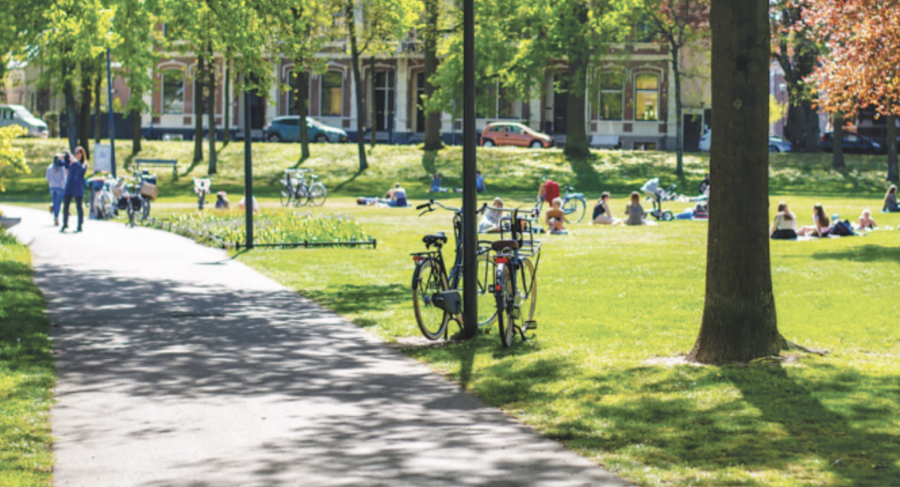Columns
Enhancing urban public spaces
Creative strategies are required to transform unconventional spaces into appealing public spaces.
Ananda Manandhar
Overhead bridges often become hangout spaces where people spend time observing the hustle and bustle of the city. Even in the small and noisy traffic island of Koteshwor junction, one can observe people resting and killing time. Similarly, plenty of people visit the open land of Koteshwor-Tinkune to play sports, and many more are there as spectators.
These examples indicate the growing demand and potential for public spaces in Kathmandu.
Having public spaces in urban areas has multiple benefits. Open spaces improve public health by providing space for physical activity and refreshment. They make places socially and economically vibrant by attracting people and activities. They serve as emergency shelters during disasters like earthquakes. If planned well, open spaces help in biodiversity conservation and groundwater recharge.
However, the situation of open spaces in Kathmandu Valley is miserable. UN-Habitat recommends 15-20 percent of urban land for open public spaces. However, according to a report published by the Kathmandu Valley Development Authority, only 2.29 percent of the land was available as open space in 2012, and the condition has not improved.
The irregular distribution of public spaces has also reinforced their unavailability. Advocates for urban public spaces recommend the availability of open spaces within walking distance, a 400-metre radius. However, many places in our cities do not have public spaces nearby, and even when they are available, they are usually gated and inaccessible.
Public parks are confined within high boundary walls and gates. Shielding public spaces from the public is a paradox, although it is supported by common reasonings such as possible vandalism, waste littering and maintenance difficulty. As a result, we are undermining the value of public spaces.
Similarly, unifunctional and exclusive planning approaches have also compromised the effectiveness of public spaces. Public parks designed for specific demographics, such as elderly people’s and children’s parks, have become a new trend. When this is not the case, the spaces still lack provisions for a diverse population: Women, children, differently abled and so on.
Furthermore, ecological dimensions are rarely considered during the development of public spaces. Local hydrology, geology, biodiversity, and natural ecosystems are disregarded. Approaches like the plantation of non-native vegetation for mere beautification, a large proportion of hardscape, and the absence of stormwater management systems show a superficial approach to public space management.
In addition to these issues, open spaces constantly threaten encroachment. Sometimes, encroachments seem like an act of conservation but end up with the controlled ownership of some individuals or groups. The Nepal Army’s occupation of part of Tundikhel is one such example. At other times, public spaces are intruded by building construction and infrastructural development.
Despite all such challenges, urban public spaces can be enhanced in many ways.
First and foremost, existing and potential open spaces should be identified; larger parks, khya (culturally significant open lands), urban pockets, riverfronts, traditional ponds, courtyards and other potential spaces should be mapped out and planned for. Encroached public lands should be reclaimed. As for new urban areas, the government should provide open spaces beforehand.
After that, identified public spaces should be managed, with due consideration of their typology and context. Larger parks can be developed with a significant proportion of native greenery and diverse spaces such as sports areas, recreational areas, water bodies, and gardens. Basic services like public toilets and drinking water services should be arranged.
Smaller spaces can be designed as urban green pockets. Machhindra Park near Jawalakhel is one good example. Cultural-communal lands such as Khya should be managed with minimal interventions.
Riverside landscape can also be capitalised as urban public spaces. Some riverside parks, such as Sankhamul Park, have already demonstrated the use value of riverfronts. However, the custom of retaining wall boundaries and ornamental landscape disassociates the river’s relationship with the land and people. Therefore, riverside development that promotes biodiversity and ecological sustainability and strengthens people’s physical and spiritual relationship with water is essential.
Next, we can capitalise on traditional open spaces like ponds and courtyards. For instance, ponds can be revitalised with proper pavements, seating spaces, and safety. Pim Bahal Pukhu at Patan and Nigu Pukhu at Thimi are perfect examples of traditional pond-based revitalisation that boosted the place’s socio-economic activities.
Furthermore, creative strategies are required to transform unconventional spaces such as overhead bridges, sidewalks, bus stops, and traffic islands into appealing public spaces. For instance, a pedestrian bridge, beyond its functional use of crossing roads, can act as a lively space if upgraded with public space amenities. Greenery addition, shed, carved-out spaces for interaction, seating spaces, and artworks are a few strategies. Likewise, wide sidewalks can be transformed into green infrastructure networks constituting rest spaces, kiosks and drinking water fountains.
Lastly, the most important step in public space management is to embrace the ‘Make it Simple’ design approach. This will significantly help tackle the issues of maintenance challenges, budgetary limitations and environmental degradation. Barrier concepts should be replaced with design and management solutions to resolve public space maintenance issues. Too many interventions and high-maintenance elements such as fountains, extravagant lighting and furniture can be intentionally avoided. Simple open ground composed of local vegetation, seating platforms, and minimal hardscape with durable materials like stones can also make beautiful parks.
Providing open spaces is not enough in itself, though. For example, the Dharahara complex, although designed as a landmark public space, isolates itself from the surrounding context. Ultimately, public spaces should be physically well interconnected with existing urban networks to make them more accessible, practical, and contextual.




 8.12°C Kathmandu
8.12°C Kathmandu















